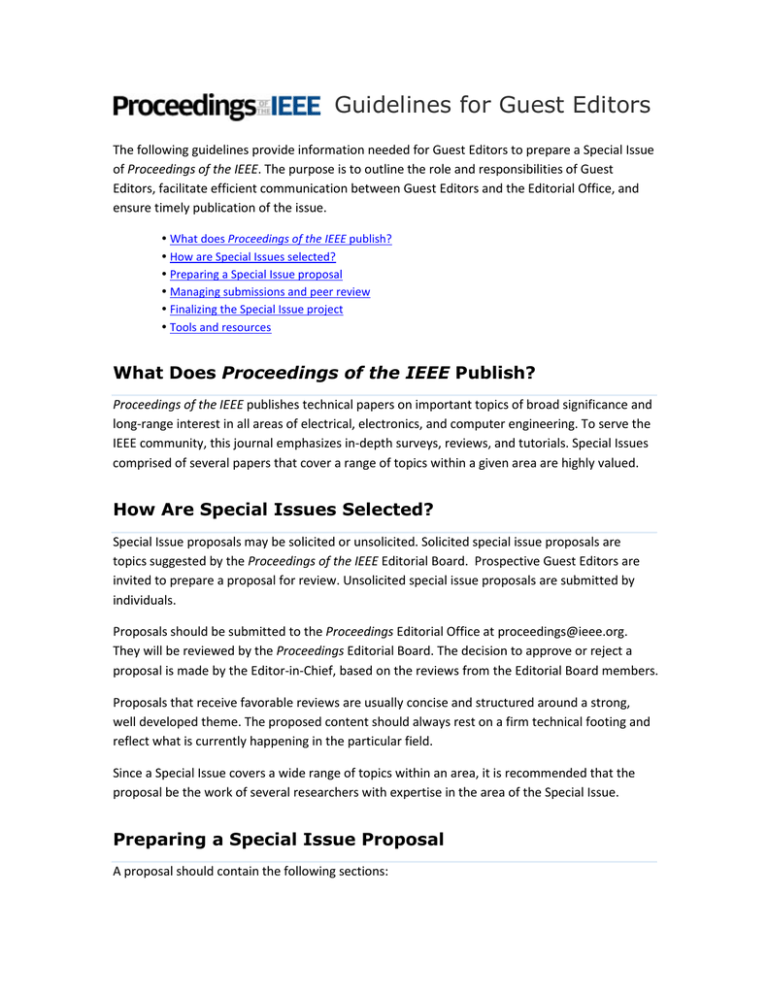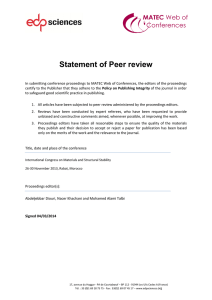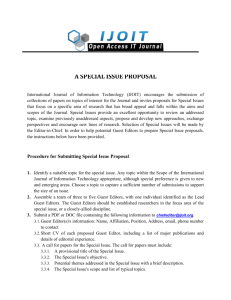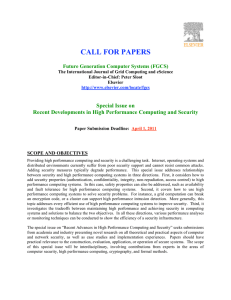Guidelines for Guest Editors
advertisement

Guidelines for Guest Editors The following guidelines provide information needed for Guest Editors to prepare a Special Issue of Proceedings of the IEEE. The purpose is to outline the role and responsibilities of Guest Editors, facilitate efficient communication between Guest Editors and the Editorial Office, and ensure timely publication of the issue. What does Proceedings of the IEEE publish? How are Special Issues selected? Preparing a Special Issue proposal Managing submissions and peer review Finalizing the Special Issue project Tools and resources What Does Proceedings of the IEEE Publish? Proceedings of the IEEE publishes technical papers on important topics of broad significance and long-range interest in all areas of electrical, electronics, and computer engineering. To serve the IEEE community, this journal emphasizes in-depth surveys, reviews, and tutorials. Special Issues comprised of several papers that cover a range of topics within a given area are highly valued. How Are Special Issues Selected? Special Issue proposals may be solicited or unsolicited. Solicited special issue proposals are topics suggested by the Proceedings of the IEEE Editorial Board. Prospective Guest Editors are invited to prepare a proposal for review. Unsolicited special issue proposals are submitted by individuals. Proposals should be submitted to the Proceedings Editorial Office at proceedings@ieee.org. They will be reviewed by the Proceedings Editorial Board. The decision to approve or reject a proposal is made by the Editor-in-Chief, based on the reviews from the Editorial Board members. Proposals that receive favorable reviews are usually concise and structured around a strong, well developed theme. The proposed content should always rest on a firm technical footing and reflect what is currently happening in the particular field. Since a Special Issue covers a wide range of topics within an area, it is recommended that the proposal be the work of several researchers with expertise in the area of the Special Issue. Preparing a Special Issue Proposal A proposal should contain the following sections: 1. Introduction/Overview: The overall theme of the proposed Special Issue should be described in this section. Sufficient background material to illustrate the rationale of the proposal should also be provided. It is advised to stress why the topic of the proposed Special Issue is important to the Proceedings readers and why its contents will be of interest to a diverse group of audience in different areas of specialty. 2. Tentative list of papers and prospective authors: A successful special issue is made up of a carefully planned collection of papers invited from leading contributors to the field covered by the issue. A few sentences on each paper as well as how it ties into the theme of the special issue should be provided in this section. Brief information on each potential author should be provided as well. It is recommended that the coverage and role of each article in the issue can be defined in advance so that all relevant angles of the topic can be covered and overlaps between articles can be minimized. Since Proceedings of the IEEE serves the international community, it is desirable to be as geographically inclusive as possible. If the subject deems necessary, the coverage must include academic as well as industry perspective. Authors should be encouraged to include applications to whatever extent possible. It is also desired that the Special Issue begins with a brief but comprehensive overview paper to provide context, technical insight, and perspective for our readers. 3. Suggested timeline: Typically 12 to 18 months are required for the preparation and publication of a Special Issue after the approval of the proposal. The time frame for each of the stages of the Special Issue development should be indicated in the proposal. Below is a sample schedule: Submission of papers: Feb 15, 2016 Reviews back to authors: Apr 15, 2016 Submission of revised papers: Jun 15, 2016 Final decision for all papers: Aug 15, 2016 Complete issue to Editorial Office: Sep 15, 2016 Publication: Early 2017 Once the timeline is agreed upon, Guest Editors are expected to adhere to the schedule to the best of their ability. 4. Proposed length of the final articles: The typical page budget for a Special Issue is approximately 140 to 160 pages. Guest Editors are urged to actively manage this budgetary constraint. It is recommended that the number of pages allocated to each paper be determined in advance as a guide for authors. If the page count total exceeds substantially, consideration will be given to splitting the material into two issues. If the page count total falls substantially below 100, consideration will be given to publishing the material as a special section. 5. Information on Guest Editors: Please provide names, affiliations, contact information, and brief biographies of all Guest Editors. Managing Submissions and Peer Review Once the proposal is approved, please confirm the list of papers, deadlines, and page count with the Editorial Office as early as possible. From then on, the Editorial Office will be in contact on a regular basis regarding status and progress. Submission Guest Editors are encouraged to reach out to prospective authors as soon as the Special Issue proposal is approved. Authors should submit their articles to the Proceedings ScholarOne Manuscript site (http://mc.manuscriptcentral.com/pieee) once their papers are ready. Once logged in, authors can go to Author Center and follow step-to-step instructions to submit their manuscripts. During the submission process, authors should choose the special issue title under “Issue Entry Header” to submit their papers to the Special Issue. Authors are asked to strive to make their papers as accessible as possible to the general electrical engineering readership of this journal. Authors are also encouraged to use color figures and submit multimedia material along with their papers for review to enhance the information contained in the articles. Proceedings does not have a specific template and does not require manuscripts to be submitted in any specific layout. However, authors can use the template for IEEE Transactions (https://www.ieee.org/publications_standards/publications/authors/author_templates.html) to get a rough estimate of the page count. Open Access Proceedings of the IEEE is a hybrid journal, allowing either traditional manuscript submission or Open Access (author-pays OA) manuscript submission. If the Open Access option is selected, the author commits to pay the discounted $1,750 OA fee in order to enable unrestricted public access. If the author selects traditional submission, the article will be available to all qualified subscribers and purchasers via IEEE Xplore. No OA payment is required for traditional submission. Peer review All papers intended for publication in Proceedings of the IEEE should be subject to a fully independent peer-review process to raise the level of the content of the published papers. Guest Editors are responsible for managing the review process and for ensuring the quality of the issue. Proceedings of the IEEE uses ScholarOne Manuscripts – http://mc.manuscriptcentral.com/pieee to manage the submission and peer review of articles. All Guest Editors will have access to ScholarOne Manuscripts and will take the roles of Chief Editor (CE) and Associate Editor (AE) in ScholarOne Manuscripts. Only one will serve as Chief Editor, while all serve as Associate Editors. The responsibilities and functions of each role are described below: Chief Editor (CE): Once a manuscript is submitted to the Special Issue, it is assigned to CE. CE has to assign an AE for the paper, which can be himself/herself or any other co-guest editor. CE is able to check the status of the paper from this point on, but AE takes direct actions with regard to reviewer assignments and paper decisions. Associate Editor (AE): All Guest Editors, including CE, serve as AEs. AE is notified by e-mail when a paper has been assigned to him/her. AE has the task of finding and assigning reviewers. AE also makes the final decision on that paper. For Editor guides and tutorials on ScholarOne Manuscripts, visit: http://mchelp.manuscriptcentral.com/gethelpnow/training/editor/. In order to reduce the length of the review process, it is recommended that papers be sent out for review as soon as they arrive. Each article must be reviewed by a minimum of three qualified reviewers, with the exception that two reviews may be considered sufficient when a Guest Editor serves as the third reviewer. Assigning more than three reviewers as backup is recommended. Reviewers with an apparent conflict of interest should be avoided. Reviewers are requested to return their reviews within three to four weeks. All reviewers will be reminded when their reviews are due in a week, and again when the reviews are past due. Once three reviews are returned for a paper, AE will be notified by e-mail and should make a decision promptly. If the paper needs to be revised, authors will be given 14 days (for minor revision) or 30 days (for major revision) to submit a revised version. AE can modify this deadline in the decision e-mail. Revised papers will follow the same work flow. Plagiarism and CrossCheck In November 2012, the PSPB approved a new policy that requires all IEEE content to be screened for possible plagiarism. To support this new policy, all manuscript submissions in ScholarOne Manuscripts will be uploaded automatically to the plagiarism detection tool, CrossCheck. CrossCheck compares submitted manuscripts against a large database of published technical papers, and provides editors with a summary report that highlights the similarity to previously published work. Guest Editors are requested to follow up to isolate and review the high-scoring papers as necessary. Finalizing the Special Issue Project Once a paper is accepted, the author will receive the acceptance e-mail along with detailed instructions on how to prepare the final submission. Authors are requested to upload all final files to ScholarOne Manuscripts. Guest Editors should inform authors that IEEE assumes that material submitted to it for publication has been properly released. It is the responsibility of the authors, not the IEEE, to determine whether disclosure of their material requires the prior consent of other parties and, if so, to obtain the necessary permissions. To finalize the issue, Guest Editors will be asked to provide “Scanning the Issue” and paper decks to the Editorial Office as soon as all papers are finalized. Scanning the Issue and paper decks A Special Issue begins with a "Scanning the Issue" article, which is written by Guest Editors. This article introduces the issue to our readers and briefly reviews the contents of each paper. It is typically composed of four parts: 1. An introductory paragraph that sets the stage for the reader and basically provides a rationale for why a Special Issue is timely at this point. 2. A section that provides some context for the reader with regard to how the subject of this Special Issue is distinguishable from other closely related topics. Sometimes a little history of the topic is appropriate here. 3. A section that introduces the details of the coverage. It contains a summary of each paper in the order that the papers will appear in the published issue. Any interesting pieces of related information about the individual coverage of the paper or the authors can be pointed out here. 4. A final section that summarizes the article, pointing out what has not been included herein, where additional information can be found on other related topics, and where research and future developments are headed. Acknowledgements can also be included in this section. Guest Editors’ photographs and biographies will appear with Scanning the Issue. It is requested that Guest Editors provide this material, together with a completed copyright form. Guest Editors are also asked to supply a concise, one-sentence summary of the paper, called a deck, for each paper. The deck appears under the title of each paper in the Table of Contents as well as in the paper itself. It allows readers to quickly scan and get the gist of the article. Promotional activities Guest Editors will be invited to participate in the promotion of their Special Issues. Tools and Resources Proceedings of the IEEE: http://www.ieee.org/proceedings Proceedings ScholarOne Manuscripts site: http://mc.manuscriptcentral.com/pieee ScholarOne Manuscripts Tutorials: http://mchelp.manuscriptcentral.com/gethelpnow/ Author Tools: http://www.ieee.org/publications_standards/publications/authors/authors_journals.html Intellectual Property Rights: http://www.ieee.org/publications_standards/publications/rights/index.html Author FAQ: http://www.ieee.org/publications_standards/publications/authors/publications_faq.html


